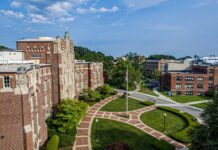WASHINGTON – Nursing homes and other long-term care facilities will be required to have full sprinkler systems throughout their buildings, for the first time, under a new regulation to be issued by the U.S. Centers for Medicare & Medicaid Services. Existing facilities will have until 2013 to comply with the new rules or be ineligible for Medicare and Medicaid payments, the agency said.
About 3 million Americans live in the nation’s 16,000 nursing homes. Under previous CMS regulations, newly constructed and rehabilitated nursing homes had to be equipped with sprinkler systems. Until now, however, existing facilities were not required by the federal government to have such systems.
Although fatal fires in nursing homes are rare, a July 2004 report by the nonpartisan Government Accountability Office estimated that automatic sprinkler systems could decrease the chance of fire-related deaths by 82 percent, the CMS said in a news release. There has never been a multiple-fatality fire in a facility with sprinklers that would have met the new regulation’s requirements, the agency said.
“CMS is taking further action to protect the lives of our beneficiaries through a more comprehensive and effective approach to fire safety,” Kerry Weems, acting administrator of the CMS, said in a Wednesday statement. “In the past, certain older facilities were exempt from having an automatic sprinkler system, but we now will hold all 16,000 nursing homes in the nation to this standard.”
Since March 2005, CMS has required long-term care facilities that don’t have sprinklers to install battery-operated smoke alarms in all patient rooms and public areas. It has also stepped up the frequency of fire safety inspections, and it already includes fire safety violation data on its Nursing Home Compare Web site, as well as information on the extent to which nursing homes have sprinkler systems.
The CMS rules follow the fire-safety guidelines developed by the National Fire Protection Association, and all new sprinkler systems installed as a result of this rule will have to meet NFPA technical specifications.
To be in compliance with the new rules, nursing homes must have sprinkler coverage in resident rooms; kitchen, dining and activity areas; corridors; attics; canopies; overhangs; offices; waiting areas; closets; storage areas for trash and linen; maintenance areas; and other specified areas.
“This is an important new rule for protecting the health and safety of persons living in long-term care facilities such as nursing homes who are, by definition, some of the most vulnerable among us,” Weems said.
“It is widely believed by fire-safety experts that automatic sprinkler systems are the single most effective fire-protection-step facilities can take.”
The U.S. Centers for Medicare & Medicaid Services, a division of the U.S. Department of Health & Human Services, is the federal agency charged with overseeing the national insurance programs for low-income and disabled. It also sets regulations for facilities that receive such funds. For more information, go to www.cms.hhs.gov.
No posts to display
Sign in
Welcome! Log into your account
Forgot your password? Get help
Privacy Policy
Password recovery
Recover your password
A password will be e-mailed to you.












